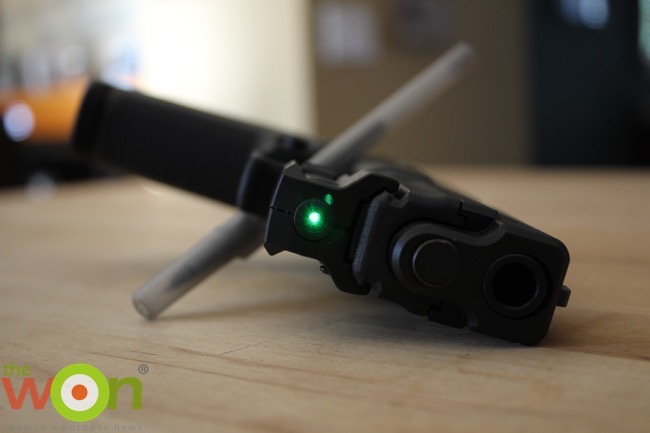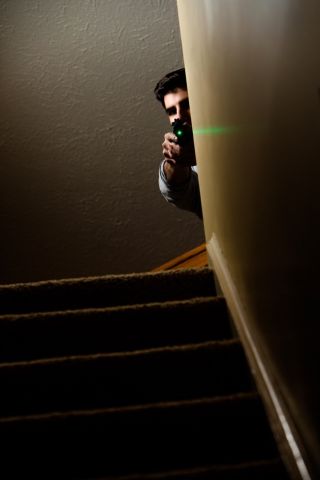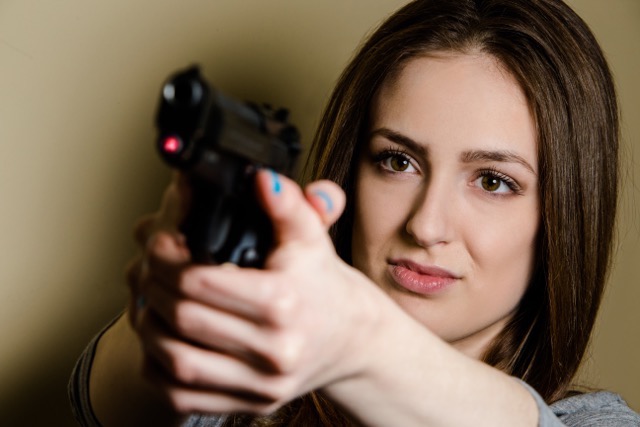If you have kids, you might be familiar with the game “Red Light, Green Light, 1-2-3,” but as a shooter, when I hear “red light, green light” I automatically think of laser sights. When they first became commercially available for firearms, lasers came only in red. Now, thanks to newer technology and research, we have the option to purchase our optics in red or green. But did you ever wonder why lasers are only marketed in red or green? What about blue, or pink or orange? Do you even know where the word laser comes from?
The word laser is actually an acronym for Light Amplification by Stimulated Emission of Radiation. Lasers themselves have come a long way from when they were first developed in the 1940s. With the advancement of technology, now anyone can afford to upgrade her pistols with laser sights.

I recently reviewed the new Spartan Laser by LaserMax. What’s cool about the Spartan is that you can install it on most semi-automatic pistols. If you decided to buy a laser sight, would you want it in red or green? I took a look at some reasons to consider each color. Here’s what I found:
Red:
Green:
Knowing the above, I ran my own unscientific test. In broad daylight on a sunny day, I was unable to see a red laser on my target at about 25 feet, but still able to see the green. I played around with my distances and lighting conditions: Other than in bright daylight, I was able to see both, especially as I reduced the light. In a low-light situation, I’d be comfortable with either color.
As I’ve already covered, there are many benefits to shooting and training with a laser:

That said, there are also some misconceptions about lasers:

The list of responses and/or questions as to why you choose to train and shoot with a laser never ends. I find that 9 times out of 10, the people who make negative comments are the ones who haven’t trained or shot while using a laser.
It’s now commonplace to purchase a pistol with a laser already integrated. Most manufacturers work with the leading laser manufacturers and have worked their designs flawlessly into the frame of the gun. They’re so well designed you don’t feel any extra bulk in the grip, even though that’s generally where the laser is based. Guide-rod lasers and grip lasers are also readily available if you want to retrofit your pistol. These are easily installed at home, without the need for a gunsmith. Guide-rod lasers are manufactured specifically for certain pistols, ensuring proper fit. And then there’s the new LaserMax Spartan, which is now available in a laser and light combination. The Spartan will fit on almost any semi-automatic pistol by connecting to your preferred location on the bottom rail. If you’re a revolver fan, No worries—LaserMax makes lasers for wheel-guns, too.
It’s impossible to say whether a green or red laser would work better for you. Variations in the human eye, degrees of color blindness, and other vision issues can affect how an individual perceives light, color and, ultimately, which laser they can see better. Both colors have benefits and work well. Either color is better than not having one.

Whether you’re purchasing a pistol with an integrated laser or buying an accessory laser for your existing handgun, rifle or even shotgun, that tiny beam of red or green light can be a terrific aid to your shooting and your safety. Do your research and see which color laser is best for you. Then grab one and start training.
It used to be red that meant stop. Now, according to companies like LaserMax, green means stop, too.
Annette Doerr is a freelance outdoor writer and business services consultant living in suburban New York. This married mother of two is an NRA Certified Pistol Instructor and Range Safety Officer. Annette is not only passionate about the sport of shooting, she also loves helping new shooters get involved, especially women and teens. An active equestrian, she enjoys riding her American Quarter horse, Cody. She volunteers in greyhound rescue and adoption, and shares her home with Casper, a rescued racing greyhound, along with her her cat, Tony, and her husband, Bob. Visit Annette at WeShoot2.com, her personal blog. View all posts by Annette Doerr
I was what would charitably be called a mediocre shot at 15 yards with my 2-inch S&W using iron sights. Yes, all five shots would land on the paper target but those ones outside the 5 ring were just to get your attention.
I installed a Laser-Lyte on the revolver and once sighted-in, I could put all five shots in the black at 15 yards! I amazed myself. I didn’t know I was that good with the 2-inch.
Yeah, outside in sunlight the red dot disappears and I am once again Joe Mediocrity with the 2-inch. Don’t stand in the shade where I can see the red dot though.
You might surprise yourself with how your shooting will improve using a red dot sight at indoor ranges and with dry firing practice at home.
I agree, Chuck! Thank you for your comment. Until I first used the LaserMax Spartan for my review, I wasn’t a believer! It’s amazing how one small beam of light can make such a difference!
You won’t be disappointed with the Spartan, Richard! Thank you for your comment, now that it’s cold here in NY I will make sure I “cold test” my green Spartan!
I prefer red, mainly because green lasers tend to not work as well – if at all – in cold temperatures (below 40 degrees).. Cold winters in Ohio. Enjoyed your review of the Spartan, I think that’ll be my next laser.
I have both red and green LaserMax Grips on my 1911’s. I prefer the green, because it’s easier to see in daylight.